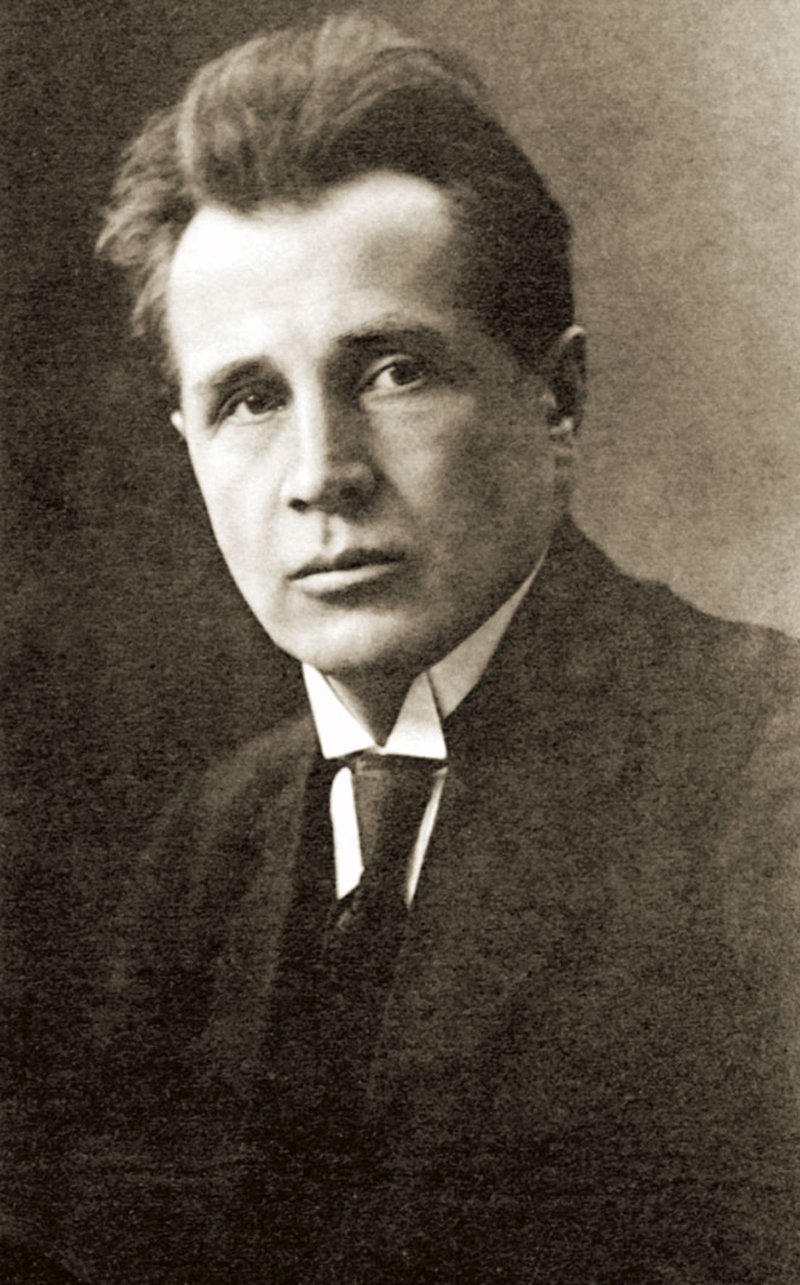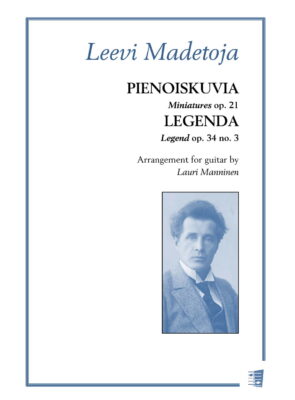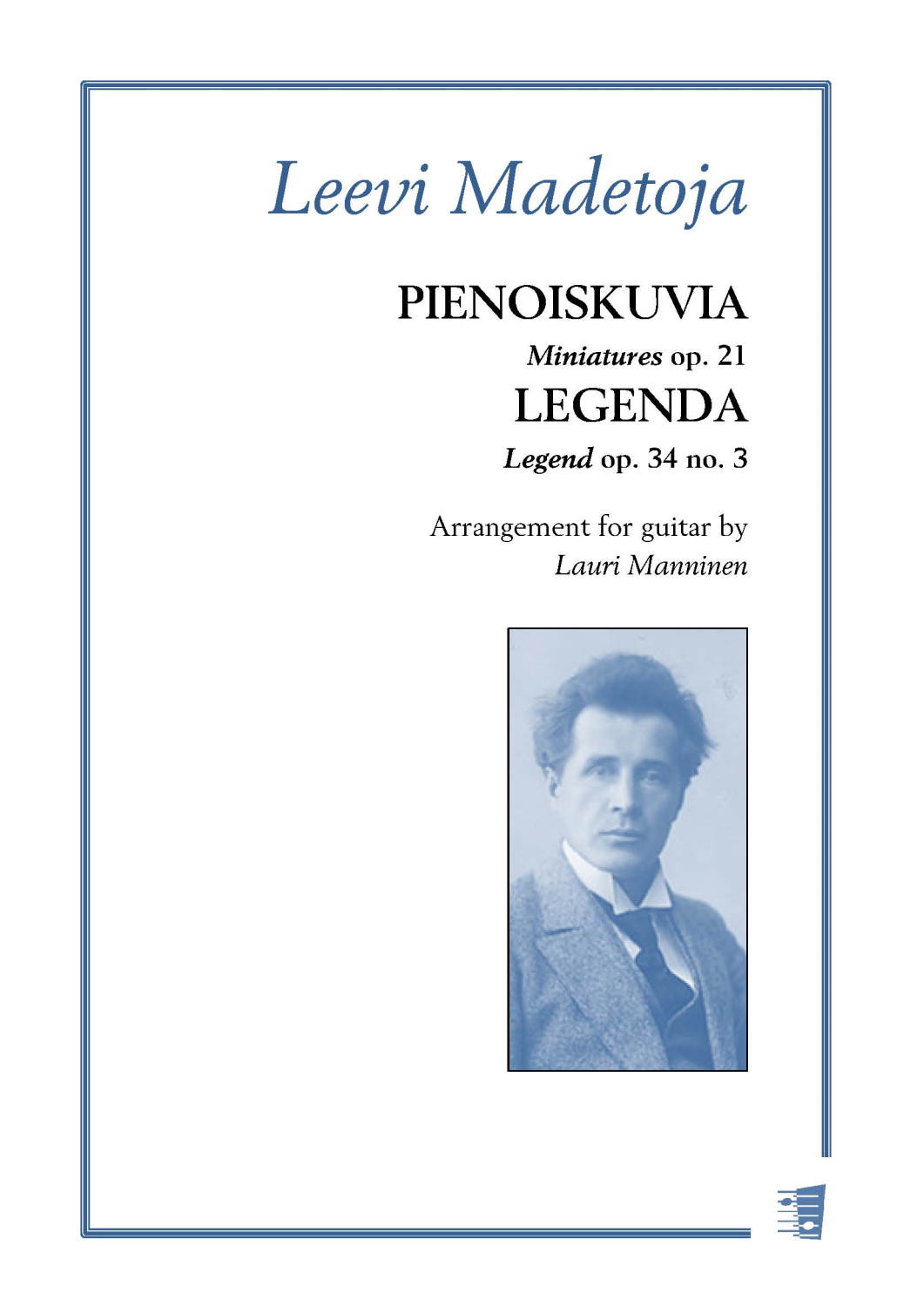
Madetoja, Leevi
A Composer from Ostrobothnia and Paris
Leevi Madetoja (17.2.1887-6.10.1947) was by nature basically a National Romantic composer. Equally pronounced in his music was, however, a classical streak aiming at balance, clarity, refinement of expression and technical polish. He also drew on a combination of the Finnish folk melody and the new French music he heard in Paris at the beginning of the century to produce a style that was entirely his own.
Madetoja had absorbed the Finnish sound into his very soul as a little boy already, while listening to the religious melodies of his native Ostrobothnia in western Finland. But while he was still at school he also drew inspiration from the Finnish art music then in the process of emerging. As a young student Madetoja also got to know the folk melodies of Northern Ostrobothnia while on a collection tour made in summer 1909. He later enriched the melodies collected by his composer colleague Toivo Kuula and ingeniously integrated them with art music in his opera The Ostrobothnians.
No less significant than this national element in his art were, however, the international stimuli provided particularly by French music at the beginning of the century but also by Richard Strauss and Carl Nielsen. At the suggestion of his friend Toivo Kuula, Madetoja chose as the destination for his first study tour in 1910-11 the city of Paris, where the music of Debussy and Dukas had for Kuula provided something in the nature of an awakening. Madetoja was, however, attracted by the more classical style of the Schola cantorum, founded on César Franck and the French symphonic tradition, headed by Vincent d’Indy. Madetoja’s plans for studying with d’Indy were reduced to one formal meeting, but the musical and cultural impressions of Paris were all the more important. Madetoja was to return to France several times in his lifetime, to work and to seek new inspiration.
Madetoja came from a humble background. His father, a ship’s mate, died in the United States without ever seeing his son, and Leevi and his brother were left to be brought up by their mother. As time went by, he began to be drawn more and more to music and became an excellent kantele player. Madetoja must surely be the only major composer in the history of world music who played the kantele, Finland’s national instrument, as his main instrument. He also studied the violin and piano on his own. In 1906 he set off to study in Helsinki, where he enrolled both at the Music Institute and the University and graduated from both four years later.
Studying under Sibelius
Madetoja was not a wonderchild, but he did have a natural talent and learnt to compose not from his teachers Armas Järnefelt, Erik Furuhjelm and Jean Sibelius but simply by composing, thus managing to acquire the means of writing both choral and orchestral music without any apparent effort. Even his very first publicly performed compositions, the solo songs Yksin and Lähdettyäs of 1908, have won themselves a permanent place in the repertoire. He was, furthermore, obliged to write his first large-scale work, the Piano Trio op. 1, on his own because his teacher, Sibelius, was abroad for the whole of spring 1909.
Madetoja’s first composition for string orchestra, Elegy (1909), was an immediate hit. In spring 1910 he wrote his first work for large orchestra, a suite to the play Chess Game by Eino Leino. In autumn 1911 he set off on a second study tour, this time to Vienna and Berlin. In Berlin he met the writer L. Onerva, whom he had got to know in connection with the performance of Leino’s play. L. Onerva and Madetoja were married in 1913. From 1912 to 1916 Madetoja held conducting appointments in first in Helsinki and then in Viipuri, and in autumn 1916 he returned to Helsinki to teach at what is now the Sibelius Academy and to write music reviews.
Naturally the music of Madetoja matured and developed, but it is not possible to identify any clear stylistic periods. The Piano Trio, though fluent still in general Romantic vein, is somewhat in the nature of an academic exercise, and although the Chess Suite and the Dance Vision (Tanssinäky) written in Vienna in 1911 do contain certain Madetojan features, the composer still seems to be searching for his idiom. By contrast, the significance of the Concert Overture written during his first winter in Paris (1910-11) appears to have been lost both to his contemporaries and to subsequent critics. In the reviews of a concert of his works given in 1913 it was overshadowed by Kullervo with its more expansive, more “national” theme. The more modest and well-proportioned Overture is, at least as regards style, nevertheless more intrinsically Madetojan than Kullervo. Both works are, however, clearly the works of a born orchestral composer.
Symphonies and operas
The first symphony by Madetoja was also a considerable achievement, proving that the 29-year-old composer was a symphonist second only to one. For Madetoja had the qualities which, as Sibelius wrote to him, “are the makings of a symphonist”.
The second symphony (1918) lasting some forty minutes is a great late Romantic symphony constructed in every way on a grander scale than the concentrated first. It seems to reflect Madetoja’s tragic personal experiences and contains some of the same melodic motifs as the piano suite The Garden of Death (Kuoleman puutarha) composed in memory of his brother killed in the Finnish Civil War of 1918. The best of the Madetoja symphonies is, however, the third (1926), and it is one of the few items in Finnish orchestral literature on a par with the works of Sibelius. Whereas the first Madetoja symphonies are similar in style to the early symphonies of Sibelius, the third may be likened most closely to precisely Sibelius’s third. While it does not quite capture the sovereignty of the first movement of Sibelius’s third, the works as a whole are of equal merit. The thing that strikes the listener is the maturity of this composer still not in his 40th year.
There is one trait in the orchestral music of Madetoja that has passed almost unnoticed but that runs from the Concert Overture through the Comedy Overture (1923) and culminates in the third symphony. Elegy and resignation are swept aside, and so is grandiloquent romantic outpouring. The parallel between the third symphonies of Madetoja and Sibelius lies precisely in that they are both classical in spirit without being neoclassical in style.
In one respect Madetoja succeeded where Sibelius did not, and that was in composing a Finnish national opera. The Ostrobothnians (1924) was a pioneering work, being in every respect the first full-weight Finnish opera. What is more, the composer compiled his own libretto and even wrote some of the poetry in it. The Ostrobothnians immediately won itself a permanent place in the repertoire.
The ballet pantomime Okon Fuoko (1930) marked the first set-back in Madetoja’s career as a composer, though critics were unanimous in their praise for the music itself. Okon Fuoko is one of the finest scores in Finnish music and possesses an unusual clarity, translucence and richness of nuance. Unfortunately the composer completed only one of the planned orchestral suites from the work. Dramatically the work was, however, declared a failure.
Most writers agree that Madetoja’s second opera, Juha (1935), is musically superior to The Ostrobothnians. The symphonic texture of Juha is far more subtle and versatile, and the fact that the composer no longer relied on the somewhat straightforward effect of the folk melody, however good, was of course a decisive step forwards and proof of maturity. Once again Juha was, however, a disappointment to the composer, since it did not enjoy a popular reception and was soon dropped from the repertoire.
The leading choral composer
Whilst Madetoja may be regarded as one of Finland’s leading orchestral and opera composers, he may well be claimed the leading choral composer, considering the extent and quality of his output. His choral works may not be as easily accessible on first hearing as the more catchy songs of Kuula or Selim Palmgren, but their own inherent quality is soon revealed on subsequent hearing. Madetoja also composed a number of cantatas and cantata-like works for various occasions.
Madetoja further produced a host of fine solo songs. Among his chamber works the delightful Violin Sonatina and the Lyric Suite full of atmosphere for cello and piano also deserve mention.
The art of Leevi Madetoja, a composer who shunned all external effects, has enjoyed a clear renaissance in the past few years. Most of the major works have been released on disc in Finland and abroad. The world of Madetoja opens up to those who wish to explore it and reveals a musical thinker of independence and originality writing in a style whose basic qualities are audible even in the very first pieces he wrote.
The writer and critic Ralf Parland gave a sensitive critique of the inherent nature of Madetoja’s music in an essay written in 1945 in which he said: “Because Madetoja never makes any concessions to the listener, his music has not gained the position it deserves in the public’s awareness. People are now beginning to open their ears to it. But that he deserves far greater attention, and that his music is both rare and precious and not simply a poor edition of the music of Sibelius – that is something they have not yet learnt.” They are now beginning to learn.
Erkki Salmenhaara
Arkihuolesi kaikki heitä
(1913)
Duration: 2
Arkihuolesi kaikki heitä
for orchestra
2.2.2.2-4.3.0.0-1.1(Glockenspiel)-str F Major
Duration: 3
Arkihuolesi kaikki heitä (arr. Kuusisto) [SALES MA
Vardagssorgerna glöm dem alla / Cast Off All Care (1913)
for medium voice and orchestra
hp-str
Duration: 2
Arkihuolesi kaikki heitä, arr. Heikkilä [F Major]
for voice and orchestra
1100-1000-00-keyb.-str
Duration: 2
Barcarola
for orchestra
2222-3210-10-str
Duration: 6
Comedy Overture
Huvinäytelmä-alkusoitto (1923)
for orchestra
323(III=bcl)2-4231-11-str Percussione: Triangolo, Tamburino
Duration: 9
Concert Overture / Konserttialkusoitto
(1911)
for orchestra
2222-4331-11-str
Duration: 10
Elämän päivät / The Days of Life
Cantata (1920)
for soprano, mixed chorus and orchestra
2.2.3(III=bcl).2-4.3.3.1-1.1-str Perc: Tamburino, Triangolo, Piatti, Gran cassa e Glockenspiel
Duration: 30
Elegy / Elegia
First movement from the Symphonic Suite op. 4 (1909)
for string orchestra
str
Duration: 5
Enkelien joululaulu / The Angels' Carol
(arr. Kuusisto) (1931)
for medium voice and orchestra
2fl/str
Duration: 2
Geisha
(1911 orch 1946)
for medium voice and orchestra
2222-4200-11-str
Duration: 2
Heijaa, heijaa / A Lullaby
(1921)
for high voice and orchestra
2021-2000-str G minor
Duration: 4
Ilta / Kväll / Evening
(1934 orch 1947)
for medium voice and string orchestra
str
Duration: 2
Ilta / Kväll / Evening
for medium voice and orchestra
2222-2000-01-str
Duration: 2
Itkisit joskus illoin / Vid avfärden [e minor]
At Evening You Would Sometimes Weep (1915)
for medium voice and orchestra
2021-2000-str
Duration: 3
Juhlamarssi / Festive March
Sarjasta Eino Leinon näytelmään Shakkipeli
for orchestra
2221-2200-12-str
Duration: 4
Kaihoni [C sharp major]
lauluäänelle ja orkesterille / for voice and orchestra (1921)
2121-2000-str
Duration: 0
Kehtolaulu / Vaggsång / Berceuse
Sa olet valkeain unten laps (1912)
for voice and string orchestra
str [a minor]
Duration: 3
Kotihin mielin
for voice and orchestra
22(II=cor.ang)22(II=cbn)-4330-00-harp-str [e minor]
Duration: 7
Kullervo - Symphonic Poem
(1913)
for orchestra
3(III+picc).2.3(III=cl.b).2-4.3.3.1-1.2-hp-str
Duration: 15
Lullaby / Kehtolaulu from Little Suite
(1912)
for orchestra
2121-2210-pf(gtr)-str
Duration: 3
Melody / Laulelma from Little Suite
(1912 orch 1913)
for viola and string orchestra
str
Duration: 3
Merituuli / Sea Breeze
(1916)
for high voice and orchestra
2222-2200-11-str
Duration: 2
Mies mieheltä / Från man till man
From Man to Man (1919)
for male chorus and orchestra
0.2.2.2-4.2.3.1-1.1(tamb. mil. & piatti)-str
Duration: 3
Okon Fuoko Suite
(1927)
for orchestra
3(III+picc).2.2.2-4.3.3.1-1.3-hp-cel-str Perc. I: Campanella, xilofono Perc. II: Castagnette, tamburo militare Perc. III: Gran cassa, piatti, tamtam, 2 pezzi di legno
Duration: 14
Overture Fantasy / Alkusoittofantasia
(1930)
for brass orchestra
crt(Eb)/2crt(Bb)/2ahn(Eb)/2thn(Bb)/bar(Eb)/tba(Eb)/timp.2 perc
Duration: 5
Pieni sarja / Little Suite
(1912 orch 1913-16)
for orchestra
1. Waltz / Valssi 3’ (2222-3000-10-hp-str) 2. Melody / Laulelma 3’ (sola viola + str) 3. Scherzino 3’ (2222-2000-str) 4. Lullaby / Kehtolaulu 3’ (2222-2000-hp-str)
Duration: 12
Pieni satu / A Little Story
(1915)
for string orchestra
str
Duration: 2
Reminiscence / Vanha muisto
1222-2000-str
Duration: 3
Song of Mourning / Hautalaulu
(1916 orch 1945)
for orchestra
2001-0000-str
Duration: 2
Suite Lyrique / Lyyrillinen sarja
(1922)
for violoncello and orchestra
2222-3200-10-str
Duration: 18
Suite Pastorale / Pastoraalisarja
(1916 orch 1931)
for orchestra
2(II+picc).2.2.2-3.2.2.1-1.1-hp-str 1. Morning / Aamu 3’ (2222-3000-11-hp-str) 2. Caprice 2’ (2222-3221-11-str) 3. Legend / Legenda 4’ (2222-1000-01-str) 4. Waltz / Valssi 2’ (2222-3221-11-str)
Duration: 11
Suomen puu / Finlands Vårdträd / Finland's Tree
(1920)
for high voice and orchestra
2222-4331-10-str
Duration: 4
Syksy / Höst / Autumn
Song Cycle (1919-30 orch 1940)
for high voice and orchestra
223(III=bcl)2—3331—11(tamtam/glockenspiel)-hp—str 1. Syksy / Höst (Autumn) (Fin/Sw) 2’ (B minor) 2. Lähtö / Uppbrott (Departure) (Fin/Sw) 3’ (A minor) 3. Luulit, ma katselin sua / Du trodde mig dig betrakta / Du dachtest, ich schaute auf dich nur / Why Did You Think I Watch’d You (Fin/Sw/Ger/Eng) 4’ (D minor) 4. Hyvää yötä / God natt (Goodnight) (Fin/Sw) 3’ (F minor) 5. Lintu sininen / Fågel blå (The Bluebird) (Fin/Sw) 2’ (G flat) 6. Ijät hyrskyjä päin / Evigt svallet emot (Eternally against the Swell) (Fin/Sw) 3’ (B minor)
Duration: 17
Symphonic Suite / Sinfoninen sarja
(1909-1910)
1. Elegy / Elegia (1909) 5’ (str) 2. Nocturne (1910) 9’ (2222-4330-10-hp-str) 3. Pastorale (1910) 4’ (23(III=c.ing)22-4330-10-str) 4. Finale (1910) 7’ (2222-4330-10-hp-str)
Duration: 25
Symphony No. 1
(1916)
for orchestra
3(III+picc)2(II+ca)3(III=bcl)2-4331-11-hp-str Percussione: Tamburo militare, Tamburino, Gran cassa, Piatti, Triangolo
Duration: 24
Symphony No. 2
(1918)
for orchestra
3(III+picc)33(III=bcl)2-5331-12-str Percussion: Snare drum, Cymbals
Duration: 43
Symphony No. 3
(1926)
for orchestra
2222-4331-11-str Percussion: Snare drum, Triangle
Duration: 31
Taistelulaulu / War Song
(1944)
for low voice and orchestra
0022-0200-11-str
Duration: 3
Terve päivä Pohjolan / Hell dig, dagning högt
Hail Northern Light (1920)
for high voice and orchestra
2222-2030-11-hp-str
Duration: 3
The Chess Game / Shakkipeli
Music for the Play by Eino Leino (1910)
for orchestra
2221-2200-12-str
Duration: 13
Väinämöisen kylvö / Väinämöinen Sows the Wildernes
(1920)
for high voice and orchestra
3(III+picc).2.2.2-4.3.3.1-1.1-hp-str Perc: Glockenspiel, Gran cassa, Tamburo militare, Piatti
Duration: 11
Väinämöisen soitto / The Playing of Väinämöinen
for soprano, baritone, mixed chorus and orchestra
2222-4331-11-str
Duration: 21
Vanhoja kansantansseja [SALES MATERIAL]
Polska I & II (1929)
for clarinet and string quintet / string orchestra
cl-str(min.11111)
Duration: 6
Yiais Sang I-II from Okon fuoko
Yiain laulut I-II / Yiai's Song I-II (1927)
for soprano and orchestra
1. 2222-1200-hp-str 2. 2220-1000-str
Duration: 6
Yrtit tummat , f minor [arr. Fougstedt]
1.1(ca).2.1-2.2.0.0-str
Duration: 3
Yrtit tummat, f minor [arr. Koskimies]
(1911)
for medium voice and orchestra
12(II+c.ing)22-3210-10-str [f minor]
Duration: 3
Yrtit tummat, g sharp minor [arr. Fougstedt]
for high voice and orchestra
2.2.2.2-2.0.0.0-str
Duration: 3


